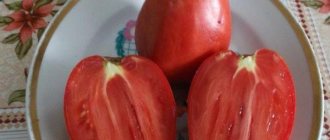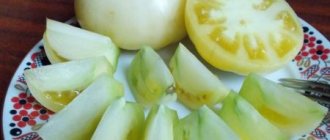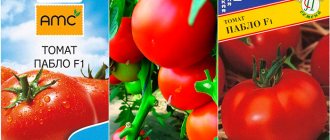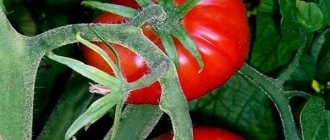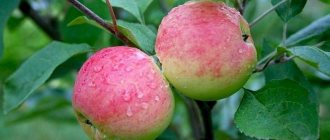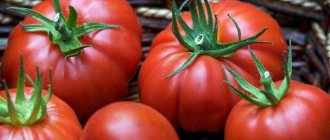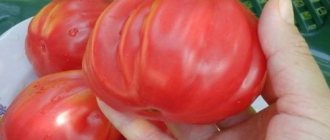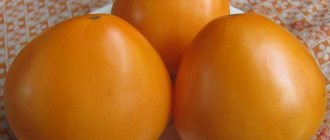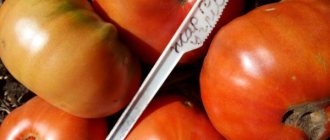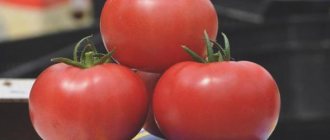The Moscow pear tomato will appeal to lovers of neat tomatoes that are easy to use universally. The variety has been included in the register in Russia since 2001 and is well known to domestic gardeners.
| Height | Landing location | Ripening time | Fruit color | Fruit size | Origin | Fruit shape |
| Medium height | Greenhouse, Open ground | Mid-season | Reds | Average | Variety | Pepper-shaped |
Description of the variety
The variety is classified as mid-late. The ripening period varies from 100 to 120 days. The speed of ripening strongly depends on the region of cultivation: with good solar activity (in the southern regions), “Moscow pear” ripens much faster.
Description of the variety:
The exterior of the bush is also variable. The height of the stem in open ground does not exceed 45-55 cm, while in a greenhouse it can stretch up to 95-105 cm. The plant type is determinate. The fruits grow in clusters of 5-6 pieces.
Fruit
Tomatoes have a characteristic pear-shaped shape, which is why the name of the variety is associated (although many vegetable growers find similarities rather with bell peppers). The ripe skin has an expressive pink color. The average weight of one tomato is 180-220 grams.
Other important features of the Moscow Pear variety:
- 4-6 seed chambers with a large number of seeds;
- Fleshy pulp;
- Expressive tomato taste.
Description of tomato variety Grushovka with photo
The Grushovka tomato is a mid-season hybrid tomato variety bred by Russian breeders and included in the State Register in 2001. It is distinguished by tasty fruits of a peculiar shape. Tomatoes of the Grushovka variety (pictured) resemble bell peppers.
You can cultivate bushes both in open ground and in greenhouses, and in the latter case the yield increases noticeably.
Variety characteristics:
- determinant (lifetime growth is limited);
- low-growing (no more than 70 cm, in greenhouses - up to 100 cm);
- mid-season (95-105 days before harvesting the first tomatoes).
The bushes are quite strong, with powerful shoots. The color of the tops is light green with gray shades. Corrugated leaves abundantly cover the bush. They are dark green in color and have carved edges.
The flowers are small, light yellow; Flowering is abundant, so you can harvest a large harvest. Inflorescences of an intermediate type begin to form already above the second leaf. After tying, 6 Grushovka tomatoes appear on each cluster, so the bushes require obligatory garter.
Grushovka tomatoes have a peculiar shape - they are very similar to bell peppers
Description of fruits
The fruits of the Grushovka tomato are quite large - on average 150-170 g, sometimes there are specimens up to 200-220 g. The classic color of the fruit is red, but it can also be raspberry. The shape is cylindrical with an extension towards the bottom. Reminds me of a drop or bell pepper. The skin is quite dense, while the surface is smooth and shiny.
The pulp is fleshy, dense, there are no voids or unripe parts. The seeds are located in four chambers, and there are not many of them. But it is not advisable to collect them, since it will not be possible to obtain full-fledged seedlings with all the characteristics of the variety. The taste is pronounced, balanced, mainly sweetish notes are present, the sourness is invisible.
Tomatoes: advantages and disadvantages
The main advantages of the “Moscow pear”:
- High yield, especially for a determinate variety;
- Possibility to grow from independently collected seeds;
- Universal cultivation in the garden or greenhouse;
- Simple agricultural technology;
- Good taste of fruits;
- Transportation without damage to product characteristics.
The disadvantages of the variety include the need to tie up the plants, despite their short stature.
REFERENCE : The unusual shape of the fruit can be interpreted as both an advantage and a disadvantage, depending on consumer preferences.
Description of the tomato variety Grushka canning, its characteristics and yield
Tomato Pear can, botanical description of the variety - the bushes are determinate, that is, when the buds begin to open, the stems stop growing. Up to 70–80 cm in height. The bush has quite large leaves, they are dark green. The variety is early - only 95–100 days pass from germination to harvesting of tomatoes. The bushes are powerful and standard. Up to 10 fruits are tied on 1 branch.
Characteristics of the fruits - unripe fruits are light green, and ripe ones are scarlet in color, they resemble pears in shape, the tomatoes are small, weighing up to 50–70 g, you can see small ribs on them. The tomatoes are very sweet and do not crack. The number of chambers with seeds is 3–4.
Recommended growing areas
The Pear can variety can be planted in any region. Only in a region with a warm climate are seedlings planted in open ground, and in the northern regions in a greenhouse. In 2008, the variety was included in the State Register of Breeding Achievements.
Productivity – up to 10 kg of tomatoes can be harvested per square meter of plantings.
Advantages of the variety
Description of benefits:
- the tomatoes are elastic, they lie perfectly;
- they are transportable, as they are quite dense;
- tomatoes have an excellent presentation.
How to plant?
Seeds need to be planted in containers in the first half of March. Before planting in cups, the seeds are placed on a napkin moistened with water. The napkin should lie on a plate. After a few days, the seeds will hatch and are planted in containers.
Make sure that the seedlings do not stretch due to lack of lighting. Illuminate the seedlings with fluorescent lamps. But at night, tomatoes need darkness, as chlorosis can form on the leaves. Because of this, simply lengthen the daylight hours with artificial lighting. When 1–2 true leaves grow, drop the seedlings into separate plastic cups.
Feed the seedlings 2-3 times. If the seedlings still stretch out, then use the immunostimulants Epin and Zircon as fertilizer. 10 days before planting the seedlings on the site, they are hardened off. Seedlings are planted on the site in early May.
Nuances of agricultural technology
The bushes are standard, which means that they do not need to be pinched. True, here, as the gardener decides, you can tear off later stepsons.
Standard bushes have compact roots; they do not grow very large. Such plants have a low, but powerful, erect trunk, but it is still advisable to tie it up. The roots are located close to the surface. Since the bushes are not tall, the seedlings can be planted more densely. The bushes need to be fed generously. They also loosen the soil, remove weeds, and water the plants. Tomatoes are harvested in mid-August. If tomatoes are picked unripe, they can be stored until the end of November.
Reviews about the variety are positive, so Igor from Moscow writes that he planted the variety after buying seeds from OBI. Almost all of his seeds sprouted. He placed the seedlings on the west window, where they stretched out. And when I planted it on the plot, by the end of June, clusters of tomatoes had already formed on the bushes.
The Grushka Canning variety is unpretentious; even a novice gardener can grow it.
Application of fruits
The fruits are compact in size, fit perfectly into any jar and tolerate heat treatment well. These qualities make them indispensable for preserving for the winter. However, due to its excellent taste and delicate aroma, most of the harvest is consumed fresh. Also, “Moskovskaya Grushovka” is excellent for processing into juice, lecho or paste.
IMPORTANT : Thanks to its high yield and excellent transportability, the variety is popular not only with ordinary gardeners, but also with professional farmers who grow tomatoes for sale or for the needs of the food industry.
Growing methods
The Red Pear tomato can be grown both according to the standard scheme - using seedlings, and without seedlings. Let's take a closer look at these two options.
Seedless method
Using this method, you can plant tomatoes both in a greenhouse and outdoors. Below are the most important points.
Soil preparation
The Red Pear variety places increased demands on the soil in which it grows.
It is very important that the soil is fertile, fertilized and loose
To ensure that the soil in the garden bed meets these requirements, dig it up before planting, loosen it and apply fertilizer:
It is better to fertilize at the same time as digging so that the minerals get into the lower layers of the soil.
Planting Tips
- Sow the seeds in such a way that there is a distance of 35-40 cm between them. Thickening is unacceptable, as it leads to loss of yield and crop diseases.
- Water the bed after sowing using warm water. If we are talking about open ground, cover the plantings with lutrasil or film on top: this measure will protect the seedlings from cold snaps.
Seedling method
A much more commonly used method. In our climate, it is the seedling option that leads to high and predictable yields.
Deadlines
To plant seedlings in the ground in May, the seeds should be planted a couple of months before this event. Optimal sowing dates: late winter - early spring.
Preparation
If you purchased the seeds in a store, there is no need for pre-sowing preparation. But if you harvested it yourself, we recommend treating the seeds in a solution of potassium permanganate. One and a half to two hours is enough to protect future tomatoes from fungus.
Priming
It is better to sow the seeds in a special seedling soil mixture sold in the store. The composition of such a mixture has already been thought out and balanced: no additional loosening or fertilizing is needed.
If you prepare the soil mixture yourself, be sure to disinfect the soil and apply the following fertilizers:
- potassium;
- phosphorus;
- growth stimulant;
- wood ash.
Conditions for seedlings
It is very important for the successful cultivation of tomato seedlings to ensure:
- competent and regular watering;
- long daylight hours;
- warm and mild microclimate.
Temperature
In order for the heat-loving crop to develop quickly and correctly, maintain the room temperature at +20-22 degrees. Remember that until the shoots appear, the temperature should be higher: +25-27 degrees.
Lighting
The place where the seedlings are located should be illuminated most of the day. As a rule, daylight hours are still short in March, so take care of additional lighting.
Picking
This procedure is performed when the seedlings form 2-3 leaves. Note that this tomato variety tolerates picking perfectly and without negative consequences.
Disembarkation
Tomato seedlings should be transplanted to an outdoor garden bed or greenhouse when the soil warms up to +15-18 degrees. It is clear that in greenhouse conditions, planting can be done much earlier. They are usually planted outside at the end of May, sometimes at the beginning of summer.
Let's get acquainted with the features of caring for red pear tomatoes.
Top dressing
Tomatoes need two minerals in particular: phosphorus and potassium. Apply these microelements throughout the growing season, keeping a break of 4 weeks between feedings. Before fruit ovaries begin to form, nitrogen fertilizing is also recommended.
In addition to mineral supplements, you can also use folk remedies:
Loosening
The soil in the tomato bed should always remain permeable. To achieve this, be sure to loosen the soil after watering and rain (if we are talking about open ground).
Since the variety is indeterminate, the above procedures cannot be avoided. Usually the bush forms one or two stems - this is quite enough to achieve the optimal ratio of the size of the fruits and their quantity.
Growing tomatoes
“Moscow pear” is a universal tomato that adapts well to any growing conditions. In most regions, cultivation is practiced using the traditional seedling method; in the southern regions, sowing without seedlings in a greenhouse is also popular.
How to prepare seeds?
To grow "Moscow pear" you need to purchase seeds once - subsequently you can collect the seed material yourself. It is important to adhere to certain rules :
- When collecting for seeds, preference is given not to the largest tomatoes, but to those grown on the healthiest bushes;
- Seed tomatoes should remain on the bush for as long as possible; they can only be harvested at full maturity;
- Seeds from tomatoes are taken only after fermentation has begun.
Purchased or independently collected seeds require pre-sowing treatment:
- Neutralization in potassium permanganate (the solution is prepared at the rate of (10 mg of potassium permanganate per 50 ml of water). The procedure is carried out for 15-20 minutes, and is guaranteed to destroy surface pathogenic bacteria;
- Stimulation with Epin or Zircon. This treatment accelerates ripening by 3-7 days and strengthens the plants' defenses.
- Keeping seeds in melt water from the second defrost for 24-48 hours before sowing. Seeds treated in this way sprout immediately when they fall into the nutrient substrate.
Sowing seed material
For seedlings, sowing is carried out in the 2-3rd decade of March - 1-2nd decade of April, with seedless sowing - no earlier than the 2nd decade of April. "Moscow pear" is very responsive to sunlight, so if possible, preference is given to later sowing.
Universal store-bought soil (or “For tomatoes and peppers”) is used as a substrate. You can also prepare the soil mixture yourself. To do this, you need to take 2 parts of turf, 1 part each of peat and sand. The substrate must be fertilized with vermicompost in an amount of at least 10% of the total mass.
The seeds are evenly distributed over the surface of the planting container, then sprinkled with 2 cm of peat and watered. Seedlings appear under the film on days 5-6, after which the cover can be removed. The recommended temperature for growing seedlings is 22-24*C.
Rules for planting seedlings
Planting of seedlings is carried out 50-60 days after sowing. The height of the seedlings at this point reaches 30 cm. “Moscow pear tree” does not like temperature changes, so planting must be planned in such a way as to avoid return frosts. The soil temperature at the time of transplantation should be at least 15*C.
Recommended planting pattern:
- The distance between plants is 50 cm;
- Row spacing – 50 cm;
- The maximum planting density is 5 plants per 1 sq.m.
Bush care
Despite the small height of the stem, the plants need staking - this is due to the large mass of ripened fruits. It is necessary to take care of the posts or trellises even before transplanting the seedlings to a permanent place, so as not to subsequently damage the root system. In a greenhouse, the top of the main stem can be tied to the greenhouse frame.
Other rules of agricultural technology:
- Partial pinching of 3-4 stems, as well as removal of leaves below the first fruit cluster;
- Moderate root watering 1-3 times a week depending on the weather;
- Loosening the top layer to avoid the formation of a hard earthen crust;
- Application of fertilizers (organic and mineral) 2-3 times per season.
Features of cultivation
You can start growing seedlings in early March. The seeds must first be checked by immersing them in a 5% salt solution (those that float are discarded). It is also necessary to take care of the soil in advance. It can be purchased in a store or made at home from three components (taken in equal quantities):
- turf land;
- peat;
- compost.
The soil must be disinfected with a 1% solution of potassium permanganate, and then washed under running water and dried. An alternative way is to keep it in the freezer for 5 days. Cassettes or wooden boxes are chosen as containers. After picking, the seedlings are distributed into individual containers - these can be plastic cups, peat pots and others.
Sequencing:
- A furrow 3 cm deep is made on the surface.
- Spread the seeds and sprinkle them with soil, then moisten them.
- Cover with a film with holes and place in a warm place (23-25 ° C).
- Regularly add additional lighting so that the daylight hours are at least 12-13 hours.
- Ventilate the greenhouse periodically
- Water the soil as it dries.
- Plant after three leaves appear.
- 10 days after this, they are fed with complex mineral fertilizer.
- Gradually the temperature is reduced to 20-22 °C.
- A week before transferring to open ground, seedlings are hardened at a temperature of 16-18 °C.
Seedlings can be grown in plastic cups with drainage holes
Important! In the south, seeds can be planted in open ground, but provided that the soil has already warmed up to 16 °C. It is worth considering that with this method of propagation, Grushovka tomato bushes grow more slowly.
Seedlings are planted in mid-May (in the south - at the end of April). If they are growing in a greenhouse, you can move them a week earlier. The planting pattern is in one line with an interval of 40 cm between the bushes. You can also plant in a checkerboard pattern with a distance between rows of 50-60 cm.
In the future, caring for the bushes is standard. Watering is regular, fertilizing is applied every 2 weeks (complex fertilizer can be given). The soil is periodically loosened, and immediately after planting it is mulched with straw or peat. They shoot regularly, leaving 3-4 strong shoots.
The bush bends under the weight of the fruit, so it needs a mandatory garter to a trellis or other support
Diseases and pests
“Moscow pear” most often suffers from the following ailments:
- Mosaic;
To prevent the spread of the disease, it is recommended to remove it from the garden bed along with the earthen clod as soon as possible.
- Brown spotting. For preventive purposes, plantings should be periodically sprayed with antifungal drugs of the “Barrier” type;
- Apex rot. It occurs due to a lack of calcium in the soil, so at the stage of planting the plant for permanent residence, you need to add a small amount of eggshells to the planting hole.
Pest and disease control
For preventive purposes, Grushovka tomato bushes are treated with a 0.5% solution of Bordeaux mixture. The procedure is carried out a week before transplanting into open ground. You can also use other fungicides, for example, “Ordan”, “Topaz”, “Profit”.
Particular attention is paid to insects. Even when grown in a greenhouse, care must be taken to control pests. Colorado beetles, mole crickets, slugs, and aphids may appear on tomatoes. Insecticides work well with them, for example: “Biotlin”, “Aktara”, “Karate”, “Decis” and others. Folk remedies are also used effectively:
- a weak solution of baking soda or ammonia;
- infusion of onion peel;
- decoction of marigold flowers;
- potato traps for Colorado beetles (potato pieces are poured into jars and dug into the ground);
- slug repellers (stone chips or crushed eggshells are sprinkled along the bed).
Attention! It is better to carry out processing in the evening, in dry and windless weather.
Productivity
With proper care and proper nutrition, up to 4 kg of fruits can be harvested from 1 Moscow pear bush, which in terms of area is up to 20 kg per 1 sq.m.
Which regions are best to grow in?
The variety shows excellent productivity throughout the Russian Federation. In the middle zone and in the north, “Moscow pear” is grown in greenhouses, in the Astrakhan region or Krasnodar Territory it is cultivated in open ground.
Growing tomatoes:
Productivity and early maturity
5-6 fruits grow on one cluster. The productivity of the bush is up to 4 kg, and the yield can be 16-20 kg/sq.m. In terms of ripening speed, it is mid-season: from germination to fruit ripening it takes from 100 to 115 days. The main purpose of the variety is canning. The advantages of the variety include unpretentiousness and high yield. Disadvantages include increased susceptibility to macrosporiosis and sometimes not good enough taste.
Planting and care
According to the description, the Grushovka tomato is an unpretentious variety. It is necessary to water the plants in the evenings, before sunset or early in the morning. During the daytime, watering should be avoided so as not to provoke late blight of fruits.
To prevent crusts from forming on the soil surface, loosening is necessary. This procedure not only helps regulate humidity levels, but also delivers air to the roots of the plants.
To get a good harvest, it is necessary to apply fertilizing. The first is carried out two weeks after planting the seedlings. During this period, complex mineral fertilizer is applied, including potassium, phosphorus, nitrogen and other useful elements. The working solution is prepared strictly according to the instructions. You can make a nutritional composition by mixing boric acid, ash, iodine. All ingredients are mixed, the resulting solution is watered at the roots of the bushes.
With a lack of watering, flowers and ovaries may fall off. Excess moisture leads to the development of various diseases.
Rotten leaves, manure, and compost saturate the plant with carbon dioxide, which is necessary for growth. And to prevent weeds from growing in the garden bed, they are mulched. This method also helps maintain the moisture level required by the plant. For mulching, use mown grass, straw or other material.
Seeds are pre-treated with Kornevin for better germination for 10 hours.
Planting seeds
For sowing in boxes, choose loose and fertile soil. Add sand and peat. Disinfect the substrate with 1% potassium permanganate. The placement depth is 2 cm. Sprinkle the top with finely dispersed soil mixture and compact it.
Until germination, the containers are kept warm under film at a temperature of 23-25 degrees.
For irrigation use settled warm water. The seedlings are irrigated with a spray bottle. Adult plants are watered at the root level at the rate of 4 liters per bush.
Seedlings are fertilized once every 10 days. Use chicken manure diluted 1:10 and mineral fertilizers “Krepysh” or “Kemira-universal”.
Basic feeding of tomatoes:
- 14 days after transplantation. Phosphorus and potassium mixtures are used.
- When flowering. Water with bird droppings and potassium.
- When tying. Wood ash and boric acid are introduced.
- During ripening. Superphosphate and sodium humate are important.
Mid-season / Mid-season
User rating: 5/5
Mid-season / Mid-season
User rating: 4/5
Early maturing / Medium growing
Moscow pear tomatoes on video
If you grew Moskovskaya Grushovka tomatoes, please write whether you liked them or not. What was the yield and taste of the fruit under your conditions? How do you rate the disease resistance of this variety? If possible, attach a photo of your tomatoes to your comment. Thank you!
Your reviews of the Moscow pear tomato and additions to the description will help many gardeners evaluate this variety more objectively and decide whether it is worth planting or not.
We think you don’t need to explain this to you, because if you are looking for new varieties of tomatoes, and by the way, you have come to the right place, it means that you are growing the products yourself. This is correct, because only we ourselves can be sure that what we grew is environmentally friendly. Well, today we will continue reviews of the best and most interesting tomatoes, and on the agenda is the “Moscow Pear” tomato, of course, its description of the variety and photo.
To choose your own varieties of crops, you need to plant them, and not just read the information, because each region has its own climate, soil, conditions, and what is suitable for this summer resident may be unacceptable for another.
Variety care
Growing the plant is no different from growing other varieties of tomatoes. Sowing, as a rule, is carried out in special seedling boxes about a month and a half before planting in the ground. The soil must contain a sufficient amount of minerals, peat, sand and other components.
Seedlings are planted in the ground at the rate of 6 plants per square meter. Care consists of simple operations:
- timely watering;
- weed removal;
- protection from diseases and pests;
- feeding with fertilizers.
Watering is carried out regularly with settled water, but do not allow water to stagnate or the soil to dry out. Systematic loosening helps maintain soil moisture levels and oxygen saturation.
It is recommended to use fertilizers once every two to three weeks. Crushed eggshells, which are poured into the hole before planting, are considered a good way to enrich the soil and fight rot. Grushovka tomatoes respond well to “natural” fertilizers: infusion, compost, etc. Compost helps mulch the soil, enriches it with organic matter and reduces the need for loosening, the roots of the plant are covered.
The fruits are collected in July-August; if the weather is good, fruiting can last until the end of September. Up to 20 kilograms of crop can be harvested from one square meter. Tomatoes are used both fresh and in various processing and canning. Due to their good keeping quality, the fruits can be picked unripe and left at home to ripen - at low temperatures this process will proceed more slowly, which will allow you to enjoy the harvest longer.
Petr V., Yuzhnouralsk: “I have been growing the Grushovka variety for a long time, I like this tomato for its beautifully shaped fruits and good yield. By gradually removing the tomatoes, I can extend the fruiting period until the end of September. Sometimes in the fall I cover the garden bed with non-woven material and pick fresh fruits from the bush until mid-October. My whole family loves Grushovka, especially the children: tomatoes remind them of light bulbs, and food turns into a game for them.”
Alexandra S., Ulyanovsk: “I decided to try the Grushovka variety after reading the description in a magazine. I liked the variety: tasty, compact, very convenient to use for preservation, and great for salads. Fruits for quite a long time
It’s just important to treat the plantings in a timely manner against diseases, otherwise one year my bushes were planted densely, and macrosporiosis began to spread between them. I didn’t notice right away, and as a result I was left with almost no harvest.”
Semyon P., Krasnoyarsk: “My father also planted Grushovka, however, that variety was old, without new qualities. When I saw a new selection in the store, I immediately decided to plant it - I didn’t regret it. The taste remains the same, the flesh is juicy and elastic, with a slight sourness - you will happily eat more than one of these fruits. But I also liked the new qualities. Plants have become more productive, disease resistant and easier to care for. I enjoy sowing this variety every year along with my other favorites.”
